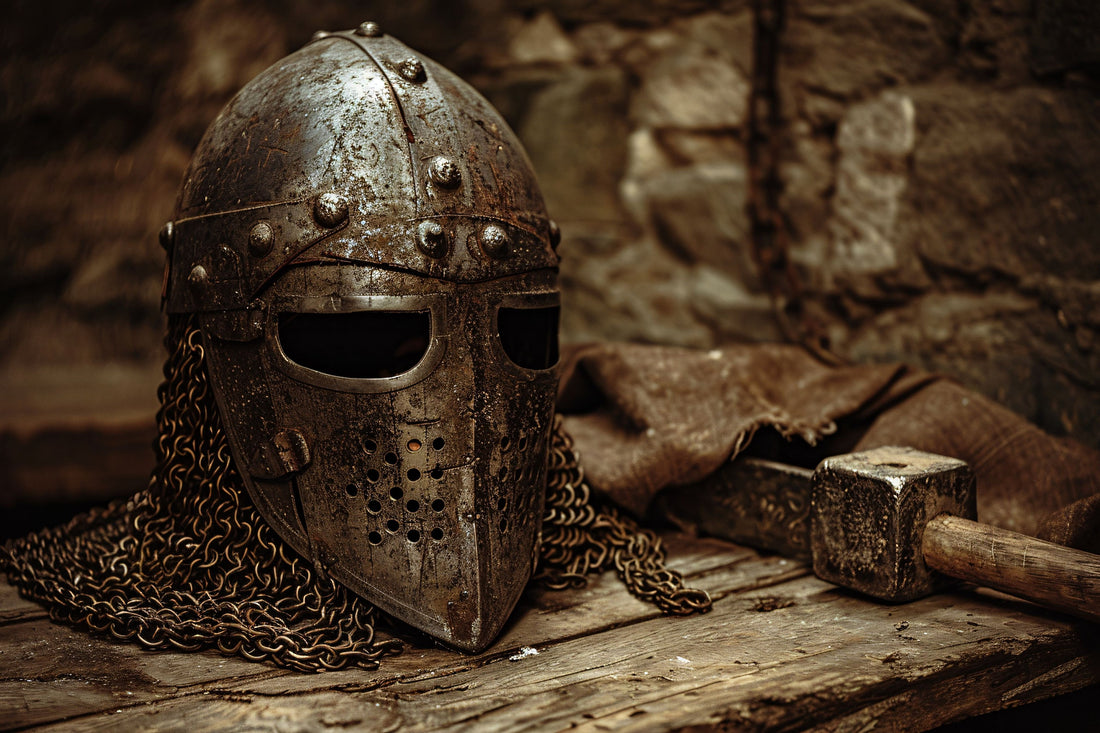
Warrior's Crown: Why Viking Helmets Are More Than Just Armor
Share
If you imagine a Viking warrior, chances are you envision a fierce battler, attired in a thick helmet, ready to fight. Viking helmets were much more than mere protection tools. They were symbols of power, leadership, and the warrior himself. But what else made them so significant beyond the fight?
The Symbolism Behind Viking Helmets
The Viking helmets were made with precision, and they were not only for protection but also to express the status of the wearer. Contrary to popular horned helmets usually shown in contemporary culture, Viking helmets were made of iron, and they were usually in a curved shape for optimal protection.
The helmets had elaborate designs in some cases, with an element of uniqueness and prestige. Such embellishments were intended to reveal the strength and heritage of the wearer.
A Viking helmet might be considered a "warrior's crown." It identified a person as a leader or an esteemed fighter among their people. Warriors wearing these helmets were feared, respected, and revered, not only for their physical power but also for their capacity to evoke loyalty and bravery.
Viking Helmets and Their Functional Design
Viking helmets were made to endure war. The rounded head and metal body permitted the helmet to absorb shock from blows, and protected the wearer from cuts and slashes.
A common Viking helmet incorporated a nose guard, safeguarding the face but not impeding eyesight or breathing. The helmet would then be equipped with a lining of leather for comfort and safety during prolonged periods of combat.
The structure and toughness of Viking helmets were central to their purpose. But most characteristic of them was the craftsmanship aspect.
Trained blacksmiths made these helmets with precision, making them not only ready for battle but also a representation of the warrior himself.
The Viking Helmet in Battle
During war, the Viking helmet was critical. The Vikings were known to be brutal in war. They employed shields, swords, and axes to overpower the enemy, and their helmets provided them with an added advantage. The helmets made the warrior safe, but they also made the warrior more confident.
But Viking helmets not only guarded the body; they guarded the warrior's mind as well. The fact that they were donning a beautifully made piece of armor probably instilled pride and strength in the warriors, allowing them to stay brave in combat.
Viking Helmets and Leadership
Viking warriors weren't merely fighting to survive; they fought to gain respect and honor. Any fighter didn't necessarily wear a Viking helmet—any warrior may have worn it, but it was also sometimes indicative of rank.
More complex helmets were worn by commanders or powerful warriors, and these indicated their status. This was significant in Viking society, where status and power were achieved through the fight.
The helmet was not just protection; it was a visual indication of the warrior's position in their society. It identified them as one who could guide their peers into combat. To many Vikings, donning a helmet was an indication of their service to their people, providing an additional level of significance to the helmet beyond mere physical protection.
Vikings Helmet vs. Athens Shield
Whereas Viking helmets were intended to guard the head and be a symbol of status, the Athens shield had another intent. The Athens shield was big and intended for battle defense. It was an essential component of the hoplite warrior's equipment. The Athens shield was intended to take impacts and guard the body of the soldier, whereas the helmet was intended for the head and leadership symbolism.
The Athens shield and the Viking helmet were both crucial pieces of equipment in ancient warfare, but they were constructed with distinct philosophies. The Viking helmet was an individual indicator of a warrior's strength and status, whereas the Athens shield was a more functional, communal defense tool.
Legacy of Viking Helmets
Viking helmets are today admired as much for their meaning as for their appearance. They represent the bold, determined nature of the Vikings, whose fighters battled to defend their people and territory. Their memory is preserved in museums, reenactments, and in the imagination of people everywhere.
The worth of a Viking helmet isn't only that it's a practical piece of armor—it's that it has history behind it. It speaks to an era when warriors were not merely battle-hardened warriors, but ideals of honor, of bravery, and of unity. Wearing a Viking helmet today is as much wearing a part of history, a call back to the strength and determination of those who wore it before.
Final Words
Viking helmets were not just practical armor. They were symbols of strength, protection, and pride. These helmets identified the warrior as a leader, a person who had the respect of all, both in the heat of battle and in everyday life. Not some common piece of equipment, the Viking helmet reflected the Viking spirit—courageous, fearless, and always ready to rumble.
